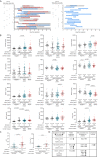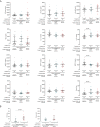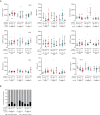Plasma Lectin Pathway Complement Proteins in Patients With COVID-19 and Renal Disease
- PMID: 33995410
- PMCID: PMC8118695
- DOI: 10.3389/fimmu.2021.671052
Plasma Lectin Pathway Complement Proteins in Patients With COVID-19 and Renal Disease
Abstract
We do not understand why non-white ethnicity and chronic kidney disease increase susceptibility to COVID-19. The lectin pathway of complement activation is a key contributor to innate immunity and inflammation. Concentrations of plasma lectin pathway proteins influence pathway activity and vary with ethnicity. We measured circulating lectin proteins in a multi-ethnic cohort of chronic kidney disease patients with and without COVID19 infection to determine if lectin pathway activation was contributing to COVID19 severity. We measured 11 lectin proteins in serial samples from a cohort of 33 patients with chronic kidney impairment and COVID19. Controls were single plasma samples from 32 patients on dialysis and 32 healthy individuals. We demonstrated multiple associations between recognition molecules and associated proteases of the lectin pathway and COVID-19, including COVID-19 severity. Some of these associations were unique to patients of Asian and White ethnicity. Our novel findings demonstrate that COVID19 infection alters the concentration of plasma lectin proteins and some of these changes were linked to ethnicity. This suggests a role for the lectin pathway in the host response to COVID-19 and suggest that variability within this pathway may contribute to ethnicity-associated differences in susceptibility to severe COVID-19.
Keywords: COVID-19; chronic kidney disease; complement; coronavirus; lectin.
Copyright © 2021 Medjeral-Thomas, Troldborg, Hansen, Gisby, Clarke, Prendecki, McAdoo, Sandhu, Lightstone, Thomas, Willicombe, Botto, Peters, Pickering and Thiel.
Conflict of interest statement
The authors declare that the research was conducted in the absence of any commercial or financial relationships that could be construed as a potential conflict of interest.
Figures




Similar articles
-
Lectin Pathway Mediates Complement Activation by SARS-CoV-2 Proteins.Front Immunol. 2021 Jul 5;12:714511. doi: 10.3389/fimmu.2021.714511. eCollection 2021. Front Immunol. 2021. PMID: 34290717 Free PMC article.
-
Complement Activation via the Lectin and Alternative Pathway in Patients With Severe COVID-19.Front Immunol. 2022 Feb 2;13:835156. doi: 10.3389/fimmu.2022.835156. eCollection 2022. Front Immunol. 2022. PMID: 35237273 Free PMC article.
-
Complement Alternative and Mannose-Binding Lectin Pathway Activation Is Associated With COVID-19 Mortality.Front Immunol. 2021 Sep 10;12:742446. doi: 10.3389/fimmu.2021.742446. eCollection 2021. Front Immunol. 2021. PMID: 34567008 Free PMC article.
-
Status of mannose-binding lectin (MBL) and complement system in COVID-19 patients and therapeutic applications of antiviral plant MBLs.Mol Cell Biochem. 2021 Aug;476(8):2917-2942. doi: 10.1007/s11010-021-04107-3. Epub 2021 Mar 21. Mol Cell Biochem. 2021. PMID: 33745077 Free PMC article. Review.
-
The lectin-complement pathway--its role in innate immunity and evolution.Immunol Rev. 2004 Apr;198:185-202. doi: 10.1111/j.0105-2896.2004.0123.x. Immunol Rev. 2004. PMID: 15199963 Review.
Cited by
-
Functional Activity of the Complement System in Hospitalized COVID-19 Patients: A Prospective Cohort Study.Front Immunol. 2021 Oct 28;12:765330. doi: 10.3389/fimmu.2021.765330. eCollection 2021. Front Immunol. 2021. PMID: 34777382 Free PMC article.
-
Immune responses to SARS-CoV-2 in dialysis and kidney transplantation.Clin Kidney J. 2022 Jul 27;15(10):1816-1828. doi: 10.1093/ckj/sfac174. eCollection 2022 Oct. Clin Kidney J. 2022. PMID: 36147709 Free PMC article. Review.
-
Compassionate Use Narsoplimab for Severe Refractory Transplantation-Associated Thrombotic Microangiopathy in Children.Transplant Cell Ther. 2024 Mar;30(3):336.e1-336.e8. doi: 10.1016/j.jtct.2023.12.017. Epub 2023 Dec 23. Transplant Cell Ther. 2024. PMID: 38145741 Free PMC article.
-
SARS-CoV-2 Spike- and Nucleoprotein-Specific Antibodies Induced After Vaccination or Infection Promote Classical Complement Activation.Front Immunol. 2022 Jul 4;13:838780. doi: 10.3389/fimmu.2022.838780. eCollection 2022. Front Immunol. 2022. PMID: 35860286 Free PMC article.
-
Complement and COVID-19: Three years on, what we know, what we don't know, and what we ought to know.Immunobiology. 2023 May;228(3):152393. doi: 10.1016/j.imbio.2023.152393. Epub 2023 May 11. Immunobiology. 2023. PMID: 37187043 Free PMC article. Review.
References
-
- Raisi-Estabragh Z, McCracken C, Bethell MS, Cooper J, Cooper C, Caulfield MJ, et al. . Greater Risk of Severe COVID-19 in Black, Asian and Minority Ethnic Populations is Not Explained by Cardiometabolic, Socioeconomic or Behavioural Factors, or by 25(OH)-Vitamin D Status: Study of 1326 Cases From the UK Biobank. J Public Health (Oxf) (2020) 42(3):451–60. 10.1093/pubmed/fdaa095 - DOI - PMC - PubMed
Publication types
MeSH terms
Substances
Grants and funding
LinkOut - more resources
Full Text Sources
Other Literature Sources
Medical

